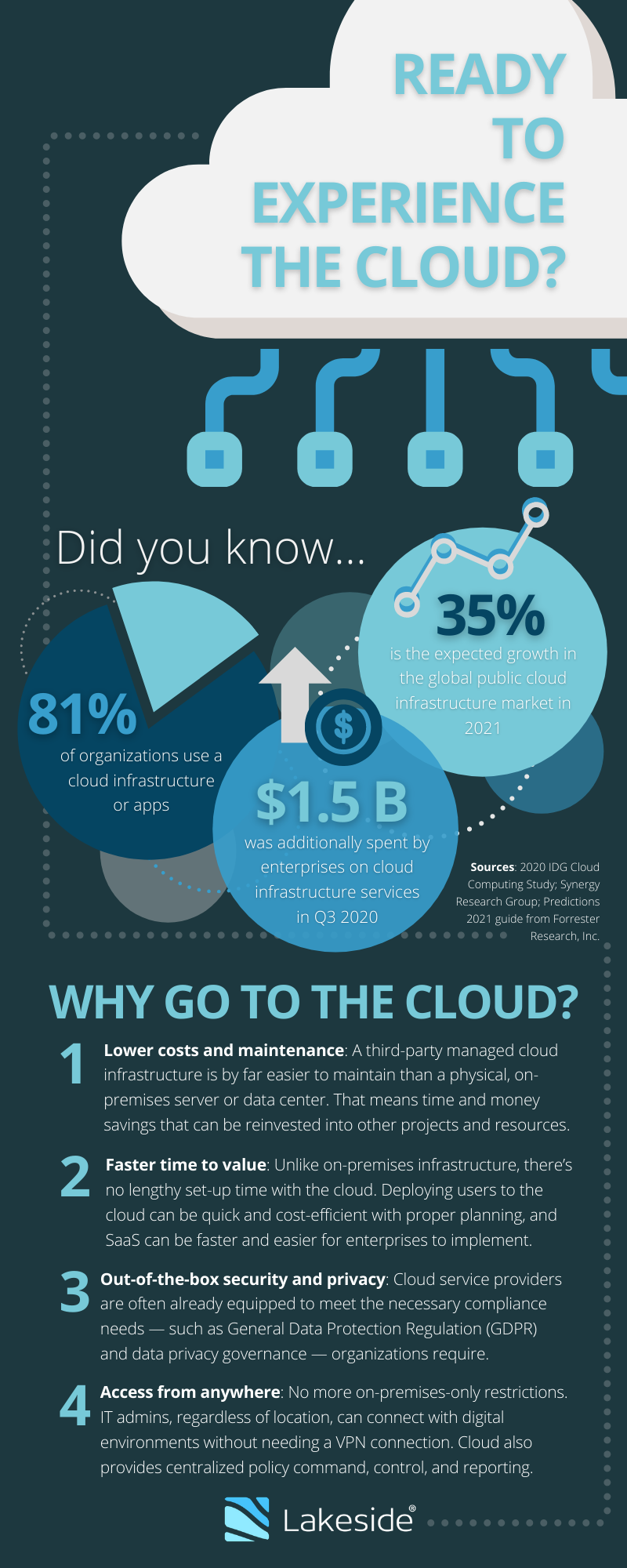
How a SaaS digital experience management solution can save time, lower IT costs, and prevent headaches
It’s pretty clear that organizations and their IT strategies have been rigorously tested lately. Not just in terms of digital employee experience, but in basic infrastructure, too.
Nearly a year after the initial spread of Covid-19 forced companies to disperse workforces and transition to remote work, their approach to IT has gone from tidy timelines to accelerated innovation. In the blink of an eye, for instance, enterprises on the cusp of cloud adoption went all in, fully embracing desktop as a service (DaaS) solutions, and, of course, software as a service (SaaS) solutions, such as digital experience monitoring management.
But to be fair, the shift to the cloud has been a long time coming anyway.
In recent years, IT teams have been catching on to the benefits of cloud-hosted environments versus on-premises systems. The 2020 IDG Cloud Computing Study reveals 81% of survey respondents said their organizations used a cloud infrastructure or apps — an 8% increase since 2018. Cloud adoption has also reached more than two-thirds in every industry, and 95% of responding organizations’ total IT environments are expected to be at least somewhat in the cloud by the end of 2021, according to the study published in June 2020.
Recent data from Synergy Research Group also showed “Covid-19 drove changes in enterprise behavior and sped up the transition from on-premise(s) operations to cloud-based services.” Enterprise spending on cloud infrastructure services (IaaS, PaaS, private cloud services) and software as a service (SaaS) went up an extra $1.5 billon in Q3 2020, resulting in a 28% overall increase in spending compared to Q3 2019.
Meanwhile, Forrester’s 2021 predictions guide forecasts that the global public cloud infrastructure market will grow 35% to $120 billion in 2021 — a 7% and $6.9 billion jump from what was originally projected for this year. That increase is the likely result of the pandemic, the report noted, which accelerated cloud adoption to help employees work from home.1
But the recent ascent to the cloud by many organizations just underscores what we already suspected — the value of a solid cloud-first approach. And for digital experience management in particular, a SaaS model offers enterprises better agility by:
- Cutting down on physical Infrastructure (servers and data centers) and freeing up staff
- Allowing easier deployment at scale
- Enabling faster startups and quicker time to value
- Working with remote endpoints
Before digging into the advantages of a cloud-based DEM solution, though, it’s worth taking a quick look at why cloud adoption makes sense in the first place.
Why Go to the Cloud?
A successful transition to the cloud can be a revelation.
It lifts the burden of maintaining a complex and expensive internal infrastructure. It provides companies with a competitive advantage. And it can create smoother, more productive digital experiences for workers spread out across regions and time zones.
But that’s just the start. Here are a few more reasons to consider the cloud:
- Lower costs and maintenance
A third-party managed cloud infrastructure is by far easier to maintain than a physical, on-premise server or data center. Without the equipment to maintain, organizations can end up saving a fair amount of time and money that can be reinvested in other resources.
- Faster time to value
Unlike on-premises infrastructure and systems, there’s no lengthy set-up time with the cloud. Deploying users to the cloud can be quick and cost-efficient with proper planning, and SaaS solutions can be faster and easier for enterprises to implement.
- Out-of-the-box security and privacy
Cloud service providers are often already equipped to meet the necessary compliance needs and regulation standards organizations require. That might include industry specific restrictions, including those for healthcare and banking, as well as General Data Protection Regulation (GDPR) and data privacy governance.
- Access from anywhere
No more on-premises-only restrictions. The cloud allows IT admins, regardless of location, to connect with digital environments without needing a VPN connection. It also provides centralized policy command, control, and reporting for IT teams.

5 Great Reasons to Adopt Cloud-Based DEM
While there are plenty of reasons to switch over to the cloud in general, there are a few more that make the case for a cloud-based digital experience management solution.
True, both on-prem and cloud DEM solutions are mostly the same in terms of functions and capabilities (IT visibility, proactive support, asset intelligence, cost savings). But there’s a notable upside to choosing SaaS: It’s often easier to use.
And without having to create and maintain internal infrastructure, organizations can save time and money.
Here are five advantages to a cloud-based DEM solution:
1. Easier to scale
Have a lot of devices to support? No problem. A multi-tenant cloud DEM solution can scale to millions of endpoints per instance, which can be replicated across geographies while adhering to privacy and language requirements.
2. Best fit for remote and hybrid work
It’s safe to assume that working from anywhere won’t be going away any time soon. And as organizations plan for what comes next in the “new normal,” work flexibility will be a big consideration. A cloud DEM solution, which can quickly scale to the edge with few limitations, works both inside and outside corporate networks for users who are dispersed across the globe, offers that flexibility, and also supports mobile devices and the internet of things (IoT) to fit the needs of an evolving digital environment.
3. No need to connect to a VPN
Instead of using a VPN to send over endpoint data to an on-prem server, a cloud solution only requires an internet connection. Data is still securely collected, even if a user is disconnected, and remote users don’t have to worry about forgetting to connect to the VPN.
4. Updates with the latest improvements
To take proactive support to the next level, IT needs the latest tools, sensors, and remediation packs for self-help and self-healing functions. A cloud solution allows easy access to the newest necessary updates.
5. Simpler integration capability
Thanks to remote work, third-party software — such as Office/Microsoft 365, and ServiceNow, Windows Virtual Desktop — is now more critical for daily tasks. But while both on-prem and cloud DEM solutions allow for integration, a cloud solution’s single application program interface (API) makes it simpler and less time-consuming to maintain and support those integrations.
Discover Lakeside’s Digital Experience Cloud
Knowing the reasons for a cloud-based platform is one thing. Experiencing the benefits is another.
With Lakeside’s Digital Experience Cloud, powered by our digital experience management solution SysTrack, organizations can realize these cloud-first advantages in a few difference ways:
- End-user experience management: Improve end-user experience and productivity through expanded IT visibility, end-user experience health scoring, self-help engagements, persona-based segmenting, and other insights.
- Digital workplace planning: Streamline cost-effective strategies for right-sizing setups, VDI migration projects, and deploying cloud-based services.
- Service desk operations: IT can take a more proactive approach by harnessing artificial intelligence capabilities for quicker remediation, ITSM optimization, automation, and “level 0” support.
- IT asset optimization: Track service performance and resource usage over time, and also identify unused/underused apps for software rationalization and license management.
By leveraging these Digital Experience Cloud advantages, organizations can move toward improved digital employee experience and realize better business outcomes, including greater employee retention and recruitment, cost savings, and technology innovation.
That includes making the transition to the cloud, when they’re ready to take the leap.
Subscribe to the Lakeside Newsletter
Receive platform tips, release updates, news and more



